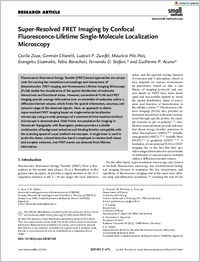Super‐Resolved FRET Imaging by Confocal Fluorescence‐Lifetime Single‐Molecule Localization Microscopy
DOKPE
- Zaza, Cecilia ORCID Centro de Investigaciones en Bionanociencias (CIBION) Consejo Nacional de Investigaciones Científicas y Técnicas (CONICET) Godoy Cruz 2390 Ciudad Autónoma de Buenos Aires C1425FQD Argentina
- Chiarelli, Germán University of Fribourg
- Zweifel, Ludovit P. University of Basel
- Pilo‐Pais, Mauricio University of Fribourg
- Sisamakis, Evangelos PicoQuant GmbH Rudower Chaussee 29 (IGZ) 12489 Berlin Germany
- Barachati, Fabio PicoQuant GmbH Rudower Chaussee 29 (IGZ) 12489 Berlin Germany
- Stefani, Fernando D. ORCID Centro de Investigaciones en Bionanociencias (CIBION) Consejo Nacional de Investigaciones Científicas y Técnicas (CONICET) Godoy Cruz 2390 Ciudad Autónoma de Buenos Aires C1425FQD Argentina; Departamento de Física, Facultad de Ciencias Exactas y Naturales Universidad de Buenos Aires Güiraldes 2620 Ciudad Autónoma de Buenos Aires C1428EHA Argentina
- Acuna, Guillermo P. ORCID University of Fribourg
- 02.05.2023
Published in:
- Small Methods. - Wiley. - 2023
confocal microscopy
super-resolution microscopy
DNA-PAINT
single molecule fluorescence
DNA origami
FRET
FLIM
English
Fluorescence Resonance Energy Transfer (FRET)-based approaches are unique tools for sensing the immediate surroundings and interactions of (bio)molecules. FRET imaging and FLIM (Fluorescence Lifetime Imaging Microscopy) enable the visualization of the spatial distribution of molecular interactions and functional states. However, conventional FLIM and FRET imaging provide average information over an ensemble of molecules within a diffraction‐limited volume, which limits the spatial information, accuracy, and dynamic range of the observed signals. Here, an approach to obtain super‐resolved FRET imaging based on single‐molecule localization microscopy using an early prototype of a commercial time‐resolved confocal microscope is demonstrated. DNA Points Accumulation for Imaging in Nanoscale Topography (DNA‐PAINT) with fluorogenic probes provides a suitable combination of background reduction and binding kinetics compatible with the scanning speed of usual confocal microscopes. A single laser is used to excite the donor, a broad detection band is employed to retrieve both donor and acceptor emission, and FRET events are detected from lifetime information
- Faculty
- Faculté des sciences et de médecine
- Department
- AMI - Chimie macromoléculaire
- Language
-
- English
- Classification
- Chemistry
- License
- Open access status
- hybrid
- Identifiers
-
- DOI 10.1002/smtd.202201565
- ISSN 2366-9608
- Persistent URL
- https://folia.unifr.ch/unifr/documents/324849
Other files
Statistics
Document views: 97
File downloads:
- smallmethods-2023-zaza: 191
- smtd202201565-sup-0001-suppmat: 102

